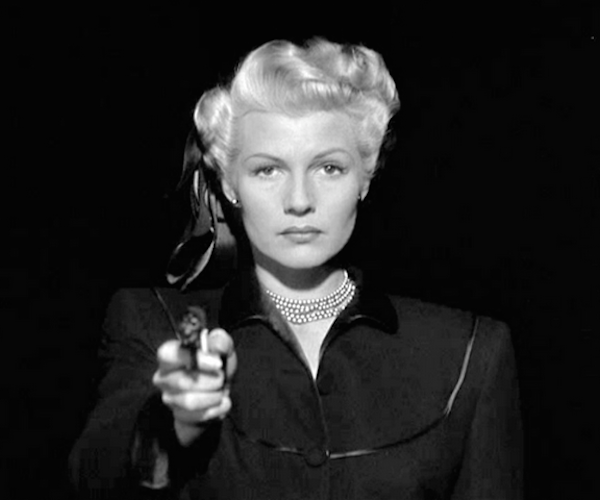Film Review: Rita Hayworth Centennial Celebration Winds Down
The Lady from Shanghai is a black comedy of manners, a “film noir” near-masterpiece.

Rita Hayworth in “The Lady from Shanghai.”
By Gerald Peary
The Brattle Theatre’s Rita Hayworth series winds down Monday, August 27, with a couple of lame, fairly late Hayworths, Separate Tables (1958) and The Money Trap (1966). No wonder the Brattle added on, for Tuesday, August 28, a reprise of one of Hayworth’s best, the Orson Welles-directed Lady from Shanghai (1948).
Once upon a time Separate Tables was a prestige movie, lauded for its Academy Award performances from David Niven and Wendy Hiller and for its literate screenplay from Terence Rattigan’s popular stage success. Rita Hayworth seemingly chose wisely with this “A” picture. Years later, Separate Tables has lost its flavor and power, Rattigan’s heartbreak English resort of “the lonely, the desperate, the deserted” now seems community theater bombast. The creaky story is damaged further by Delbert Mann’s pedestrian direction, a middlebrow fake concern for “the little people,” and an abominably ugly visual style. The fabled ensemble acting? Deborah Kerr, Burt Lancaster, etc.? Except for Hiller, it’s a sham.
Hayworth looks terrible. Something had happened since the glamor of her Pal Joey (1958) just a year earlier. Her beautiful hair is sprayed and deadened, her body mummified. She seems ill at ease, and with good reason, because her role as divorcee, Ann Shankland, makes no dramatic sense. When Burt Lancaster dumps the more deserving and enticing Hiller for a return to Ann, his zombie ex-wife, even a Hayworth devotee must ask why.
The Money Trap is from the good-cop-goes-greedy-and-pays-with-his-life sub-genre. Glenn Ford and Ricardo Montalban start with stern policeman integrity but soon descend into the maelstrom. The use of Hayworth here is disgraceful. For the last time in film, she is linked with Glenn Ford, but this is no Gilda. He’s the star, she’s relegated to a degrading supporting role. Rita is his has-been ex-girlfriend, Rosie, from the old neighborhood, before he got cop rich with a swimming pool, manservants, and a marriage to Elke Sommer. To put it kindly, Hayworth doesn’t look in very good health, yet director Burt Kennedy’s camera lingers on her puffy, failing façade.
After a couple of scenes of Ford and Hayworth reunited in misery, she is—Plot alert!—pushed (off-screen) from the rooftop where they once made love. Even her death is discussed in terms which cross the line and malign Hayworth herself, rumored then to have alcohol problems. “I can’t stand drunken women,” complains Montalban. “There is something so un-feminine about them. Believe me, it’s no loss to the world.”

Glenn Ford and Rita Hayworth in “The Money Trap.”
The Lady from Shanghai. What a mismatch, given that Hayworth and Orson Welles once were married, though they were legally separated when he offered her the female lead in his new movie. Hayworth accepted immediately, and Welles responded by cutting off the locks of her lustrous red hair and dying what was left a near-platinum blonde. All in preparation for her vamp-and-viper role as “Shanghai Elsa” Bannister. “Orson was and is a very great director, one of a kind, like Chaplin and that Italian-Visconti,” Hayworth told the New York Times. “We were separated but we were still friends.”
The Lady from Shanghai has survived its abysmal box office when it was released, and the charges that Welles was, as expected, a wastrel, shooting ninety days instead of sixty, burning through his Columbia Pictures budget, inflating it from $1,250,000 to $2,000,000. It took many years to gain its reputation, but the movie at last makes perfect sense. It’s a black comedy of manners, a “film noir” near-masterpiece. In a sense, it’s The Maltese Falcon at sea, with Sydney Greenstreet, Peter Lorre, and Mary Astor being replaced by Everett Sloane, Glenn Anders, and Hayworth, respectively. However, Welles’s Michael O’Hara more resembles stupid, girl-crazy Archer than sly Sam Spade. He falls hard for Rita’s frigid Elsa, an icicle who never melts. Like The Maltese Falcon’s Brigitte O’Shaugnessy, she’s a lie within a lie, a labyrinth leading to nowhere. Here is a dame that you can’t trust.
Were Welles and Hayworth, estranged in marriage, really as fond of each other as Hayworth contended? It’s possible to see strong elements of psychodrama motivating Welles’s cruel (but compelling) conception of Elsa’s character. When, in the film’s justly famous climax, Elsa lies bleeding to death among the shattered mirrors of a funhouse, Welles, as filmmaker, seems quite pitiless about the mortal turn of events. Doesn’t she deserve her dastardly fate?
Welles’s O’Hara walks out of the funhouse unscathed, breathing air that this misadventure (Welles’s marriage?) is over. Rita Hayworth’s revenge was a court divorce from Welles in 1947. “I couldn’t take his genius twenty-four hours a day,” she finally confessed.
Gerald Peary is a Professor Emeritus at Suffolk University, Boston, curator of the Boston University Cinematheque, and the general editor of the “Conversations with Filmmakers” series from the University Press of Mississippi. A critic for the late Boston Phoenix, he is the author of nine books on cinema, writer-director of the documentaries For the Love of Movies: the Story of American Film Criticism and Archie’s Betty, and a featured actor in the 2013 independent narrative Computer Chess. He is currently at work co-directing with Amy Geller a feature documentary, The Rabbi Goes West.
